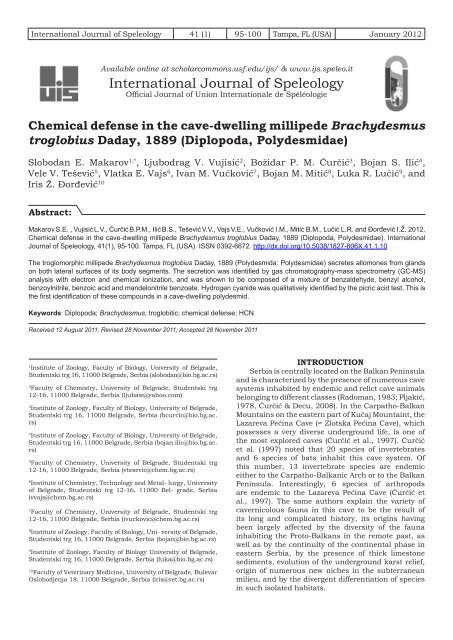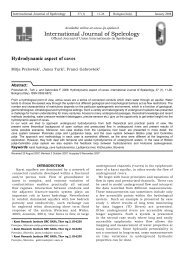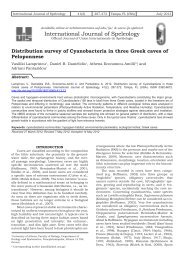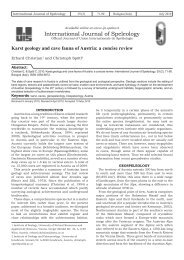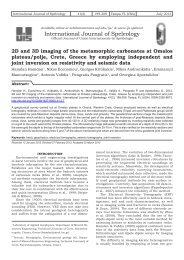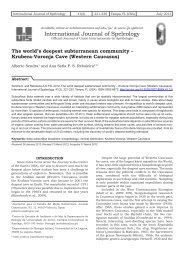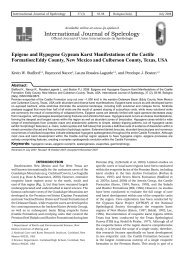Chemical defense in the cave-dwelling millipede Brachydesmus ...
Chemical defense in the cave-dwelling millipede Brachydesmus ...
Chemical defense in the cave-dwelling millipede Brachydesmus ...
Create successful ePaper yourself
Turn your PDF publications into a flip-book with our unique Google optimized e-Paper software.
International Journal of Speleology 41 (1) 95-100 Tampa, FL (USA) January 2012<br />
Available onl<strong>in</strong>e at scholarcommons.usf.edu/ijs/ & www.ijs.speleo.it<br />
International Journal of Speleology<br />
Official Journal of Union Internationale de Spéléologie<br />
<strong>Chemical</strong> <strong>defense</strong> <strong>in</strong> <strong>the</strong> <strong>cave</strong>-dwell<strong>in</strong>g <strong>millipede</strong> <strong>Brachydesmus</strong><br />
troglobius Daday, 1889 (Diplopoda, Polydesmidae)<br />
Slobodan E. Makarov 1,* , Ljubodrag V. Vujisić 2 , Božidar P. M. Ćurčić 3 , Bojan S. Ilić 4 ,<br />
Vele V. Tešević 5 , Vlatka E. Vajs 6 , Ivan M. Vučković 7 , Bojan M. Mitić 8 , Luka R. Lučić 9 , and<br />
Iris Ž. Đorđević 10<br />
Abstract:<br />
Makarov S.E. , Vujisić L.V., Ćurčić B.P.M., Ilić B.S., Tešević V.V., Vajs V.E., Vučković I.M., Mitić B.M., Lučić L.R. and Đorđević I.Ž. 2012.<br />
<strong>Chemical</strong> <strong>defense</strong> <strong>in</strong> <strong>the</strong> <strong>cave</strong>-dwell<strong>in</strong>g <strong>millipede</strong> <strong>Brachydesmus</strong> troglobius Daday, 1889 (Diplopoda, Polydesmidae). International<br />
Journal of Speleology, 41(1), 95-100. Tampa, FL (USA). ISSN 0392-6672. http://dx.doi.org/10.5038/1827-806X.41.1.10<br />
The troglomorphic <strong>millipede</strong> <strong>Brachydesmus</strong> troglobius Daday, 1889 (Polydesmida: Polydesmidae) secretes allomones from glands<br />
on both lateral surfaces of its body segments. The secretion was identified by gas chromatography-mass spectrometry (GC-MS)<br />
analysis with electron and chemical ionization, and was shown to be composed of a mixture of benzaldehyde, benzyl alcohol,<br />
benzoylnitrile, benzoic acid and mandelonitrile benzoate. Hydrogen cyanide was qualitatively identified by <strong>the</strong> picric acid test. This is<br />
<strong>the</strong> first identification of <strong>the</strong>se compounds <strong>in</strong> a <strong>cave</strong>-dwell<strong>in</strong>g polydesmid.<br />
Keywords: Diplopoda; <strong>Brachydesmus</strong>; troglobitic; chemical <strong>defense</strong>; HCN<br />
Received 12 August 2011; Revised 28 November 2011; Accepted 28 November 2011<br />
1<br />
Institute of Zoology, Faculty of Biology, University of Belgrade,<br />
Studentski trg 16, 11000 Belgrade, Serbia (slobodan@bio.bg.ac.rs)<br />
2<br />
Faculty of Chemistry, University of Belgrade, Studentski trg<br />
12-16, 11000 Belgrade, Serbia (ljubaw@yahoo.com)<br />
3<br />
Institute of Zoology, Faculty of Biology, University of Belgrade,<br />
Studentski trg 16, 11000 Belgrade, Serbia (bcurcic@bio.bg.ac.<br />
rs)<br />
4<br />
Institute of Zoology, Faculty of Biology, University of Belgrade,<br />
Studentski trg 16, 11000 Belgrade, Serbia (bojan.ilic@bio.bg.ac.<br />
rs)<br />
5<br />
Faculty of Chemistry, University of Belgrade, Studentski trg<br />
12-16, 11000 Belgrade, Serbia (vtesevic@chem.bg.ac.rs)<br />
6<br />
Institute of Chemistry, Technology and Metal- lurgy, University<br />
of Belgrade, Studentski trg 12-16, 11000 Bel- grade, Serbia<br />
(vvajs@chem.bg.ac.rs)<br />
7<br />
Faculty of Chemistry, University of Belgrade, Studentski trg<br />
12-16, 11000 Belgrade, Serbia (ivuckovic@chem.bg.ac.rs)<br />
8<br />
Institute of Zoology, Faculty of Biology, Uni- versity of Belgrade,<br />
Studentski trg 16, 11000 Belgrade, Serbia (bojan@bio.bg.ac.rs)<br />
9<br />
Institute of Zoology, Faculty of Biology University of Belgrade,<br />
Studentski trg 16, 11000 Belgrade, Serbia (luka@bio.bg.ac.rs)<br />
10<br />
Faculty of Veter<strong>in</strong>ary Medic<strong>in</strong>e, University of Belgrade, Bulevar<br />
Oslobodjenja 18, 11000 Belgrade, Serbia (iris@vet.bg.ac.rs)<br />
INTRODUCTION<br />
Serbia is centrally located on <strong>the</strong> Balkan Pen<strong>in</strong>sula<br />
and is characterized by <strong>the</strong> presence of numerous <strong>cave</strong><br />
systems <strong>in</strong>habited by endemic and relict <strong>cave</strong> animals<br />
belong<strong>in</strong>g to different classes (Radoman, 1983; Pljakić,<br />
1978, Ćurčić & Decu, 2008). In <strong>the</strong> Carpatho-Balkan<br />
Mounta<strong>in</strong>s on <strong>the</strong> eastern part of Kučaj Mounta<strong>in</strong>t, <strong>the</strong><br />
Lazareva Peć<strong>in</strong>a Cave (= Zlotska Peć<strong>in</strong>a Cave), which<br />
possesses a very diverse underground life, is one of<br />
<strong>the</strong> most explored <strong>cave</strong>s (Ćurčić et al., 1997). Ćurčić<br />
et al. (1997) noted that 20 species of <strong>in</strong>vertebrates<br />
and 6 species of bats <strong>in</strong>habit this <strong>cave</strong> system. Of<br />
this number, 13 <strong>in</strong>vertebrate species are endemic<br />
ei<strong>the</strong>r to <strong>the</strong> Carpatho-Balkanic Arch or to <strong>the</strong> Balkan<br />
Pen<strong>in</strong>sula. Interest<strong>in</strong>gly, 6 species of arthropods<br />
are endemic to <strong>the</strong> Lazareva Peć<strong>in</strong>a Cave (Ćurčić et<br />
al., 1997). The same authors expla<strong>in</strong> <strong>the</strong> variety of<br />
<strong>cave</strong>rnicolous fauna <strong>in</strong> this <strong>cave</strong> to be <strong>the</strong> result of<br />
its long and complicated history, its orig<strong>in</strong>s hav<strong>in</strong>g<br />
been largely affected by <strong>the</strong> diversity of <strong>the</strong> fauna<br />
<strong>in</strong>habit<strong>in</strong>g <strong>the</strong> Proto-Balkans <strong>in</strong> <strong>the</strong> remote past, as<br />
well as by <strong>the</strong> cont<strong>in</strong>uity of <strong>the</strong> cont<strong>in</strong>ental phase <strong>in</strong><br />
eastern Serbia, by <strong>the</strong> presence of thick limestone<br />
sediments, evolution of <strong>the</strong> underground karst relief,<br />
orig<strong>in</strong> of numerous new niches <strong>in</strong> <strong>the</strong> subterranean<br />
milieu, and by <strong>the</strong> divergent differentiation of species<br />
<strong>in</strong> such isolated habitats.
96<br />
Makarov, Vujisić, Ćurčić, Ilić, Tešević, Vajs, Vučković, Mitić, Lučić, and Đorđević<br />
Figure 1. Structure of identified compounds from <strong>Brachydesmus</strong><br />
troglobius Daday, 1889: 1 - benzaldehyde, 2 - benzyl alcohol, 3<br />
- benzoylnitrile, 4 - benzoic acid, 5- mandelonitrile benzoate, 6 -<br />
hydrogen cyanide. Compounds 1-5 identified from hexane extract by<br />
GC-FID and GC-MS, and compound 6 identified by picric acid test.<br />
One of <strong>the</strong> typical <strong>cave</strong>-dwell<strong>in</strong>g <strong>in</strong>habitants <strong>in</strong> <strong>the</strong><br />
Lazareva Peć<strong>in</strong>a Cave is <strong>the</strong> <strong>millipede</strong> <strong>Brachydesmus</strong><br />
troglobius Daday, 1889 (Fig. 3). This species is a<br />
true troglobite, <strong>in</strong>habit<strong>in</strong>g <strong>cave</strong>s <strong>in</strong> Austria, Slovenia,<br />
Croatia, Montenegro, Hungary, and Serbia (Enghoff<br />
& Kime, 2010). The aims of this work were to <strong>the</strong><br />
identify <strong>the</strong> chemical component <strong>in</strong> <strong>the</strong> defensive<br />
fluids <strong>in</strong> one <strong>cave</strong>-dwell<strong>in</strong>g <strong>millipede</strong>; to test <strong>the</strong><br />
possibility that adaptation to underground life has<br />
<strong>in</strong>fluenced <strong>the</strong> chemical <strong>defense</strong> mechanism; to<br />
compare <strong>the</strong> results on this species with previously<br />
analyzed surface-dwell<strong>in</strong>g relatives, and to confirm<br />
cyanogenesis <strong>in</strong> polydesmids.<br />
MATERIAL AND METHOD<br />
Millipedes were collected dur<strong>in</strong>g May 2010 <strong>in</strong> <strong>the</strong><br />
Lazareva Peć<strong>in</strong>a Cave, village Zlot, near Bor, eastern<br />
Serbia. The defensive secretions of ten females and<br />
ten males were extracted <strong>in</strong> hexane (0.5 ml) for 3<br />
m<strong>in</strong>. To elim<strong>in</strong>ate <strong>the</strong> effects of composition-alter<strong>in</strong>g<br />
oxidation and degradation of compounds, a portion<br />
of <strong>the</strong> extracts was analyzed by GC and GC-MS<br />
immediately after preparation.<br />
Analyses were performed on an Agilent 7890A<br />
GC system equipped with 5975C <strong>in</strong>ert XL EI/CI<br />
MSD and a FID detector connected by capillary flow<br />
technology 2-way splitter with make-up gas. An HP-5<br />
MS capillary column (Agilent Technologies, 25 mm<br />
i.d., 30 m length, 0.25 μm film thickness) was used.<br />
Samples were <strong>in</strong>jected <strong>in</strong> splitless mode. The <strong>in</strong>jection<br />
volume was 1 μl and <strong>the</strong> <strong>in</strong>jector temperature was<br />
250°C. The carrier gas (He) flow rate was 1.3 ml/m<strong>in</strong><br />
at 40°C (constant pressure mode) while <strong>the</strong> column<br />
temperature was programmed l<strong>in</strong>early <strong>in</strong> a range<br />
of 40-300°C at a rate of 10°C/m<strong>in</strong> with an <strong>in</strong>itial<br />
1-m<strong>in</strong> and f<strong>in</strong>al 8-m<strong>in</strong> hold. The transfer l<strong>in</strong>e was<br />
heated at 280°C. The FID detector temperature was<br />
300°C. Electron ionization mass spectra EI MS (70<br />
eV) were acquired <strong>in</strong> an m/z range of 35-550. The ion<br />
source temperature was 230°C and <strong>the</strong> quadrupole<br />
temperature was 150°C. <strong>Chemical</strong> ionization mass<br />
spectra CI MS (150eV) was obta<strong>in</strong>ed <strong>in</strong> positive mode<br />
with isobutane as reagent gas. The scan range was<br />
m/z 60-550. The CI ion source temperature was<br />
250°C and <strong>the</strong> quadrupole temperature was 150°C.<br />
A library search and mass spectral deconvolution<br />
and extraction were performed us<strong>in</strong>g NIST AMDIS<br />
(Automated Mass Spectral Deconvolution and<br />
Identification System) software, ver. 2.64. The retention<br />
<strong>in</strong>dices were calculated from <strong>the</strong> retention times of<br />
Fig. 2. GC-MS total ion chromatogram of hexane extract of <strong>Brachydesmus</strong> troglobius Daday, 1889. Peak 1: benzaldehyde; peak 2: benzyl<br />
alcohol; peak 3: benzoylnitrile; peak 4: benzoic acid; peak 5: mandelonitrile benzoate; *solvent impurities.<br />
International Journal of Speleology, 41 (1), 95-100. Tampa, FL (USA). January 2012
<strong>Chemical</strong> <strong>defense</strong> <strong>in</strong> <strong>the</strong> <strong>Brachydesmus</strong> troglobius<br />
97<br />
Fig. 3. <strong>Brachydesmus</strong> troglobius Daday, 1889 from <strong>the</strong> Lazareva Peć<strong>in</strong>a Cave, village Zlot, near Bor, East Serbia. A – male, B – female.<br />
Scale l<strong>in</strong>e = 2 mm.<br />
n-alkanes which were <strong>in</strong>jected after <strong>the</strong> sample under<br />
<strong>the</strong> same chromatographic conditions. The search<br />
was performed aga<strong>in</strong>st our own library conta<strong>in</strong><strong>in</strong>g<br />
4,951 spectra, and <strong>the</strong> commercially available Adams,<br />
NIST05 and Willey07 libraries conta<strong>in</strong><strong>in</strong>g more than<br />
500,000 spectra.<br />
The relative percentages of <strong>the</strong> identified<br />
compounds were computed from <strong>the</strong> correspond<strong>in</strong>g<br />
GC-FID peak areas.<br />
Hydrogen cyanide secreted from <strong>the</strong> live <strong>millipede</strong>s<br />
was qualitatively exam<strong>in</strong>ed by <strong>the</strong> picric acid test.<br />
Filter paper, previously impregnated with a saturated<br />
solution of picric acid, was sprayed with 5% sodium<br />
bicarbonate. Live <strong>millipede</strong>s were placed onto <strong>the</strong> wet<br />
filter paper and squeezed forcefully (five specimens<br />
of each species). If <strong>the</strong> <strong>millipede</strong> secretions conta<strong>in</strong>ed<br />
hydrogen cyanide, <strong>the</strong> color of <strong>the</strong> portion of <strong>the</strong> paper<br />
sta<strong>in</strong>ed by <strong>the</strong> secretions gradually turned orange<br />
(Noguchi et al., 1997).<br />
RESULTS AND DISCUSSION<br />
Millipedes are known to produce chemical<br />
compounds aga<strong>in</strong>st predators (Shear et al., 2007).<br />
The secretions <strong>in</strong>clude different qu<strong>in</strong>ones, phenolic<br />
compounds, organic acid, qu<strong>in</strong>azol<strong>in</strong>es, monoterpens,<br />
or cyanogenic compounds (Eisner et al., 1978).<br />
<strong>Chemical</strong> studies <strong>in</strong>dicate that <strong>the</strong> quantitative<br />
and qualitative differences <strong>in</strong> <strong>millipede</strong> allomones<br />
show some phylogenetic patterns. For example, <strong>the</strong><br />
production of hydrogen cyanide and o<strong>the</strong>r cyanogenic<br />
compounds is restricted to most of <strong>the</strong> representatives<br />
of <strong>the</strong> order Polydesmida (Omura et al., 2002a, 2002b;<br />
Taira et al., 2003; Shear et al., 2007). In <strong>the</strong>se <strong>millipede</strong>s<br />
<strong>the</strong> predom<strong>in</strong>ant components are hydrogen cyanide<br />
and benzaldehyde, as well as phenol, benzoic acid,<br />
benzoylnitrile (= benzoyl cyanide) and mandelonitrile.<br />
Their profiles seem to be species-specific among<br />
Polydesmida. Fur<strong>the</strong>rmore, a recent study has shown<br />
that <strong>the</strong> composition of defensive fluids <strong>in</strong> some<br />
representatives of <strong>the</strong> family Polydesmidae <strong>in</strong>dicate<br />
<strong>in</strong>terspecific or <strong>in</strong>tergeneric differences and that<br />
<strong>the</strong>y may be useful <strong>in</strong> chemotaxonomy (Makarov et<br />
al., 2010). Hydrogen cyanide is a toxic component,<br />
believed to function as a defensive agent aga<strong>in</strong>st<br />
predators (Zagrobelny et al., 2008).<br />
Defense glands are present on somites 5, 7,<br />
9, 10, 12, 13, and 15-18 <strong>in</strong> B. troglobius. In <strong>the</strong>se<br />
pleurotergites, <strong>the</strong> <strong>defense</strong> glands are located on <strong>the</strong><br />
lateral sides on both paranotal expansions, as <strong>in</strong> many<br />
o<strong>the</strong>r polydesmids. The GC and GC-MS analyses of<br />
<strong>the</strong> hexane extracts <strong>in</strong> all specimens (male and female)<br />
of B. troglobius showed five volatile compounds: <strong>the</strong><br />
major components were benzaldehyde (54.7%) and<br />
benzoylnitrile (30.7%); <strong>the</strong> m<strong>in</strong>or ones were benzoic<br />
acid (10.9%), mandelonitrile benzoate (2.0%) and<br />
benzyl alcohol (1.7%) (Table 1; Figs. 1 and 2). These<br />
compounds were identified by comparison of EI mass<br />
spectra <strong>in</strong> <strong>the</strong> NIST MS Search 2.0 computerized<br />
mass spectral libraries. The CI mass spectra of<br />
benzaldehyde, benzyl alcohol, benzoylnitrile, benzoic<br />
acid and mandelonitrile benzoate showed <strong>the</strong> presence<br />
of quasi-molecular ions at m/z 107, 109, 132, 123<br />
and 238, respectively. In addition, hydrogen cyanide<br />
was detected with <strong>the</strong> picric acid test. No significant<br />
difference <strong>in</strong> <strong>the</strong> amounts of <strong>the</strong> components was<br />
observed between <strong>the</strong> sexes <strong>in</strong> <strong>the</strong> analyzed species.<br />
F<strong>in</strong>d<strong>in</strong>g of <strong>the</strong> mandelonitrile benzoate is <strong>in</strong>terest<strong>in</strong>g<br />
<strong>in</strong> <strong>the</strong> light of recent papers of Kuwahara et al. (2011).<br />
These authors found that mandelonitrile benzoate is<br />
produced <strong>in</strong> large amounts toge<strong>the</strong>r with hydrogen<br />
cyanide follow<strong>in</strong>g shake-disturbances adm<strong>in</strong>istered to<br />
several polydesmoid species. These species commonly<br />
produce mandelonitrile and benzoylnitrile. Species<br />
possess<strong>in</strong>g no benzoylnitrile, such as Oxidus gracilis<br />
C. L. Koch and Cryptocorypha sp., could also produce<br />
mandelonitrile benzoate under conditions <strong>in</strong> which<br />
International Journal of Speleology, 41 (1), 95-100. Tampa, FL (USA). January 2012
98<br />
Makarov, Vujisić, Ćurčić, Ilić, Tešević, Vajs, Vučković, Mitić, Lučić, and Đorđević<br />
Peak t R<br />
(m<strong>in</strong>) Compound<br />
Relative<br />
abundance (%) a<br />
1 6.39 Benzaldehyde 54.7<br />
2 7.63 Benzyl alcohol 1.7<br />
3 8.52 Benzoylnitrile 30.7<br />
4 9.88 Benzoic acid 10.9<br />
5 19.90 Mandelonitrile benzoate 2.0<br />
a<br />
Percentages calculated from GC-FID peak areas.<br />
Table 1. Composition of <strong>the</strong> defensive secretions <strong>in</strong> <strong>Brachydesmus</strong><br />
troglobius Daday, 1889 analyzed by GC-FID and GC-MS.<br />
benzoylnitrile was exogenously provided. However, <strong>in</strong><br />
B. troglobius (as <strong>in</strong> o<strong>the</strong>r analyzed species belong<strong>in</strong>g<br />
to <strong>the</strong> genus <strong>Brachydesmus</strong>; Makarov et al., 2010)<br />
we could not found mandelonitrile, and it is difficult<br />
to <strong>in</strong>clude <strong>the</strong> analyzed species <strong>in</strong> ei<strong>the</strong>r of <strong>the</strong> two<br />
groups of cyanogenic <strong>millipede</strong>s, as suggested by<br />
Kuwahara et al. (2011). On <strong>the</strong> o<strong>the</strong>r hand, <strong>the</strong><br />
presence of mandelonitrile benzoate <strong>in</strong> defensive fluids<br />
may be <strong>the</strong> mechanism that stabilizes mandelonitrile<br />
if <strong>the</strong> specimen is consumed by a predator; <strong>in</strong> such<br />
cases this compound will be degraded dur<strong>in</strong>g passage<br />
through <strong>the</strong> digestive tract, as proposed for some<br />
cyanogenic glucosides <strong>in</strong> Zygaena larva by Zagrobelny<br />
and Møller (2011).<br />
The chemical composition of <strong>the</strong> defensive<br />
compounds <strong>in</strong> B. troglobius <strong>in</strong> comparison with its<br />
analyzed surface-dwell<strong>in</strong>g relatives is <strong>in</strong>terest<strong>in</strong>g and<br />
<strong>in</strong>dicative (Table 2). Makarov et al. (2010) showed that<br />
between <strong>the</strong> genera Polydesmus and <strong>Brachydesmus</strong><br />
<strong>the</strong>re exist differences <strong>in</strong> <strong>the</strong> chemical composition<br />
of <strong>the</strong> defensive secretion, <strong>in</strong>clud<strong>in</strong>g <strong>the</strong> presence of<br />
mandelonitrile only <strong>in</strong> <strong>the</strong> genus Polydesmus, and<br />
benzyl alcohol and benzoic acid only <strong>in</strong> <strong>the</strong> genus<br />
<strong>Brachydesmus</strong>. Our result confirms <strong>the</strong>se f<strong>in</strong>d<strong>in</strong>gs.<br />
Mandelonitrile is absent and benzyl alcohol and<br />
benzoic acid are present <strong>in</strong> <strong>the</strong> whole body extract<br />
of B. troglobius. In addition, we confirm <strong>in</strong>terspecific<br />
differences <strong>in</strong> defensive fluids with<strong>in</strong> representatives<br />
of <strong>the</strong> genus <strong>Brachydesmus</strong>. The analyzed species<br />
differs from B. dadayi by <strong>the</strong> presence of benzoic<br />
acid (absent <strong>in</strong> B. dadayi), and from B. avalae by <strong>the</strong><br />
absence of benzyl ethyl ketone (present <strong>in</strong> B. avalae).<br />
Sher et al. (2007) have hypo<strong>the</strong>sized that<br />
adaptive responses to local conditions are important<br />
<strong>in</strong> <strong>the</strong> evolution of <strong>the</strong> diplopod secretions which<br />
are employed by <strong>millipede</strong>s for <strong>defense</strong> aga<strong>in</strong>st a<br />
variety of predators. Thus, it is not surpris<strong>in</strong>g that<br />
defensive secretions have evolved <strong>in</strong> response to local<br />
environmental conditions. Ćurčić & Makarov (1998)<br />
showed that B. troglobius completed its life-cycle<br />
<strong>in</strong> <strong>the</strong> <strong>cave</strong> system (confirmed by <strong>the</strong> f<strong>in</strong>d<strong>in</strong>g of all<br />
postembryonic stadia <strong>in</strong> <strong>cave</strong>). The selective pressure<br />
of predators <strong>in</strong> <strong>the</strong> Lazareva Peć<strong>in</strong>a Cave is lower <strong>in</strong><br />
comparison to surface habitats. It is comprised of<br />
several species of spiders, coleopterans, harvestmen,<br />
Species<br />
Compounds<br />
1 2 3 4 5 6 7 8 9 10 11 12 13 14 15 Reference<br />
<strong>Brachydesmus</strong> avalae Ćurčić & Makarov + + + + + + + Makarov et al., 2010<br />
<strong>Brachydesmus</strong> dadayi Verhoeff + + + + + + Makarov et al., 2010<br />
<strong>Brachydesmus</strong> troglobius Daday + + + + + + Present study<br />
Polydesmus complanatus (L<strong>in</strong>naeus) + + + + + + + Makarov et al., 2010<br />
Polydesmus collaris collaris C. L. Koch + + Casnati et al., 1963<br />
Polydesmus vic<strong>in</strong>us Saussure + + Casnati et al., 1963<br />
Epanerchodus japonicus Carl + + + + Mori et al., 1994<br />
Epanerchodus fulvus Haga + + + + + Kuwahara et al, 2011<br />
Pseudopolydesmus erasus (Loomis) + + + + + Duffey et al., 1977<br />
Pseudopolydesmus serratus (Say) + + + + + + + + + Conner et al., 1977<br />
Pseudopolydesmus canadensis<br />
Newport<br />
+ Eisner et al., 1975<br />
Table 2. Defensive secretion <strong>in</strong> <strong>the</strong> representatives of <strong>the</strong> family Polydesmidae. 1 – Benzaldehyde, 2 – Benzyl alcohol, 3 - Benzoylnitrile, 4 –<br />
Benzoic acid, 5 – Mandelonitrile benzoate, 6 – HCN, 7 – Benzyl methyl ketone, 8 – Benzyl ethyl ketone, 9 – Mandelonitrile, 10 – Glucoside<br />
of p-isopropil mandelic nitrile, 11 – Phenol, 12 – Guaiacol, 13 – Myristic acid, 14 – Stearic acid, 15 – Isovaleric acid.<br />
International Journal of Speleology, 41 (1), 95-100. Tampa, FL (USA). January 2012
<strong>Chemical</strong> <strong>defense</strong> <strong>in</strong> <strong>the</strong> <strong>Brachydesmus</strong> troglobius<br />
99<br />
and pseudoscorpions (Ćurčić et al., 1997). Also, it<br />
is well-known that adaptation to underground life<br />
<strong>in</strong>cludes certa<strong>in</strong> morphological adaptations, such<br />
as <strong>the</strong> reduction of pigments and eyes, elongated<br />
appendages, <strong>the</strong> appearance of additional sensitive<br />
setae, as well as some physiological and behavioral<br />
changes (Romero, 2009; Culver & Pipan, 2009). In<br />
accordance with <strong>the</strong>se facts and <strong>the</strong> overall aspects<br />
of life <strong>in</strong> subterranean habitats, we expected that <strong>the</strong><br />
number of allomones <strong>in</strong> <strong>the</strong> analyzed species could<br />
be lower or changed <strong>in</strong> comparison with surfacedwell<strong>in</strong>g<br />
species. However, our f<strong>in</strong>d<strong>in</strong>g does not<br />
confirm such a hypo<strong>the</strong>sis. Instead it presents <strong>the</strong><br />
chemical consistency of <strong>the</strong> defensive allomones, at<br />
least <strong>in</strong> polydesmid <strong>millipede</strong>s. It is as if this chemical<br />
<strong>defense</strong> mechanism has a high level of ‘conservation’<br />
and that isolation, changes <strong>in</strong> selective pressure or<br />
colonization of a different habitat have not greatly<br />
affected its character.<br />
Some f<strong>in</strong>d<strong>in</strong>gs po<strong>in</strong>t to a different role of <strong>the</strong><br />
secretory compounds <strong>in</strong> B. troglobius. In a series<br />
of papers, Zagrobelny et al., (2008), Møller (2010),<br />
Zagrobelny & Møller (2011), and Niels et al., (2011)<br />
analyzed <strong>the</strong> function of cyanogenic glucosides <strong>in</strong><br />
plants and animals, and showed that <strong>the</strong>y play several<br />
important roles <strong>in</strong> addition to <strong>defense</strong> <strong>in</strong> <strong>the</strong> life cycle<br />
of Zygaena filipendulae (L<strong>in</strong>naeus, 1758). When ready<br />
for mat<strong>in</strong>g, <strong>the</strong> perch<strong>in</strong>g females emit plumes of HCN<br />
that may serve to attract fly<strong>in</strong>g males. The females<br />
prefer males that have a high content of cyanogenic<br />
glucosides, and dur<strong>in</strong>g mat<strong>in</strong>g <strong>the</strong> male transfers<br />
a nuptial gift conta<strong>in</strong><strong>in</strong>g cyanogenic glucosides.<br />
In o<strong>the</strong>r <strong>in</strong>sect species, males are also known to<br />
transfer sem<strong>in</strong>al gifts conta<strong>in</strong><strong>in</strong>g bio-active natural<br />
products dur<strong>in</strong>g mat<strong>in</strong>g (Møller, 2010). Fur<strong>the</strong>rmore,<br />
Bellairs et al. (1983) suggested that aggregations of<br />
<strong>the</strong> Indian polydesmoid Streptogonopus phipsoni<br />
(Pocock) were ma<strong>in</strong>ta<strong>in</strong>ed by weak concentrations of<br />
benzaldehyde released from <strong>the</strong> repugnatorial glands.<br />
When alarmed, <strong>the</strong> quantity or concentration of <strong>the</strong><br />
exudate rises and <strong>the</strong> swarm disperses. This results<br />
<strong>in</strong> a dilution effect and <strong>the</strong> swarm reaggregates when<br />
<strong>the</strong> concentration falls as pockets of <strong>the</strong> appropriate<br />
concentration are sought. Experiments were<br />
carried out on <strong>the</strong> reactions of <strong>the</strong> larvae to aquatic<br />
suspensions of benzaldehyde, s<strong>in</strong>ce this substance<br />
is related to <strong>the</strong> components of <strong>the</strong> exudate of <strong>the</strong><br />
repugnatorial glands; strong concentrations repelled<br />
<strong>the</strong> larvae, whilst weak concentrations attracted<br />
<strong>the</strong>m. It is suggested that swarms may be dispersed<br />
or reaggregated by <strong>the</strong> effects of variations <strong>in</strong> <strong>the</strong><br />
concentration of components of <strong>the</strong> exudates. Such<br />
a f<strong>in</strong>d<strong>in</strong>g <strong>in</strong> both <strong>in</strong>sects and diplopods <strong>in</strong>dicates that<br />
<strong>in</strong> subterranean habitats, <strong>the</strong> secretory components<br />
found <strong>in</strong> B. troglobius may be useful <strong>in</strong> <strong>in</strong>traspecific<br />
communication, as alarm pheromones or as<br />
attractants dur<strong>in</strong>g <strong>the</strong> mat<strong>in</strong>g process.<br />
In conclusion, our results confirm cyanogenesis <strong>in</strong><br />
<strong>the</strong> family Polydesmidae. They show that specificity <strong>in</strong><br />
<strong>the</strong> chemical composition of defensive secretions could<br />
serve as criteria for <strong>millipede</strong> chemotaxonomy. They<br />
also reveal that adaptation to underground life has not<br />
led to a reduction or changes <strong>in</strong> <strong>the</strong> chemical <strong>defense</strong><br />
mechanism, at least not <strong>in</strong> <strong>the</strong> analyzed B. troglobius.<br />
ACKNOWLEDGEMENTS<br />
This study was supported by <strong>the</strong> M<strong>in</strong>istry of<br />
Education and Science of Serbia (Grants Nos.<br />
173038 and 172053). We wish to thank two<br />
anonymous referees for <strong>the</strong>ir helpful comments on<br />
<strong>the</strong> manuscript.<br />
REFERENCES<br />
Bellairs V., Bellairs R. & Goels S., - 1983 Studies on<br />
an Indian polydesmoid <strong>millipede</strong> Streptogonopus<br />
phipsoni. Life cycle and swarm<strong>in</strong>g behaviour of <strong>the</strong><br />
larvae. Journal of Zoology, 199: 31-50.<br />
http://dx.doi.org/10.1111/j.1469-7998.1983.tb06115.x<br />
Casnati G., Nenc<strong>in</strong>i G., Quilico A., Pavan M., Ricca A.<br />
& Salvatori T., 1963 - The secretion of <strong>the</strong> myriapod<br />
Polydesmus collaris collaris (Koch). Experientia,<br />
19: 409–411.<br />
http://dx.doi.org/10.1007/BF02171516<br />
Conner W.E., Jones T.H., Eisner T. & Me<strong>in</strong>wald J., 1977<br />
- Benzoyl cyanide <strong>in</strong> <strong>the</strong> defensive secretion of a<br />
polydesmoid <strong>millipede</strong>. Experientia, 33: 206–207.<br />
http://dx.doi.org/10.1007/BF02124069<br />
Culver D.C. & Pipan T., 2009 - The Biology of<br />
Caves and O<strong>the</strong>r Subterranean Habitats. Oxford<br />
University Press, 254 p.<br />
Ćurčić B.P.M., Dimitrijević R.N., Makarov S.E., Lučić<br />
L.R., Karamata O.S. & Tomić V.T., 1997 - The Zlot<br />
Cave – a unique faunal refuge (Serbia, Yugoslavia).<br />
Archives of Biological Sciences, Belgrade, 49:<br />
29P-30P.<br />
Ćurčić B.P.M. & Decu V., 2008 - Cave-dwell<strong>in</strong>g <strong>in</strong>vertebrates<br />
<strong>in</strong> Serbia. In: Makarov S.E. & Dimitrijević<br />
R.N. (Eds.) - Advances <strong>in</strong> Arachnology and<br />
Developmental Biology. Papers dedicated to Prof.<br />
Dr. Božidar Ćurčić. Inst. Zool., Belgrade; BAS,<br />
Sofia; Fac. Life Sci., Vienna; SASA, Belgrade &<br />
UNESCO MAB Serbia: 7-34.<br />
Ćurčić B.P.M. & Makarov S.E. - 1998 Postembryonic<br />
development <strong>in</strong> <strong>Brachydesmus</strong> troglobius Daday<br />
(Diplopoda: Polydesmidae) from Yugoslavia.<br />
Archives of Biological Sciences, Belgrade, 50:<br />
9P-10P.<br />
Duffey S.S., Blum M.S., Fales H.M., Evans, S.L.,<br />
Roncardi R.W., Tiemann D.L. & Nakagawa Y.,<br />
1977 - Benzoyl cyanide and mandelonitrile benzoate<br />
<strong>in</strong> <strong>the</strong> defensive secretions of <strong>millipede</strong>s.<br />
Journal of <strong>Chemical</strong> Ecology, 3: 101–113.<br />
http://dx.doi.org/10.1007/BF00988137<br />
Eisner H.E., Wood W.F. & Eisner T., 1975 - Hydrogen<br />
cyanide production <strong>in</strong> North American and African<br />
polydesmoid millipeds. Psyche, 82: 20–23.<br />
Eisner T., Alsop D., Hicks K. & Me<strong>in</strong>wald J., 1978<br />
- Defensive secretions of <strong>millipede</strong>s. In: Bett<strong>in</strong>i S.<br />
(Ed.) - Arthropod Venoms. Berl<strong>in</strong>, Spr<strong>in</strong>ger: 41-72.<br />
Enghoff H., & Kime R.D. (Eds.) 2010 - Fauna<br />
Europaea. Myriapoda. Fauna Europaea, version<br />
2.4. Available from http://www.faunaeur.org<br />
Kuwahara Y., Shimizu N. & Tanabe T., 2011 –<br />
Release of Hydrogen Cyanide via a Post-secretion<br />
Schotten-Baumann Reaction <strong>in</strong> Defensive Fluids<br />
of Polydesmoid Millipedes. Journal of <strong>Chemical</strong><br />
Ecology, 37: 232–238.<br />
http://dx.doi.org/10.1007/s10886-011-9920-9<br />
International Journal of Speleology, 41 (1), 95-100. Tampa, FL (USA). January 2012
100<br />
Makarov, Vujisić, Ćurčić, Ilić, Tešević, Vajs, Vučković, Mitić, Lučić, and Đorđević<br />
Makarov S.E., Ćurčić B.P.M., Tešević V.V., Jadran<strong>in</strong><br />
M.B., Vujisić Lj,V., Ćurčić S.B., Mandić B.M.,<br />
Sekulić T.L. & Mitić B.M.,. 2010 - Defensive<br />
Secretions <strong>in</strong> Three Species of Polydesmids<br />
(Diplopoda, Polydesmida, Polydesmidae). Journal<br />
of <strong>Chemical</strong> Ecology, 36: 978–982.<br />
http://dx.doi.org/10.1007/s10886-010-9847-6<br />
Møller B.L., 2010 - Functional diversifications of cyanogenic<br />
glucosides. Current Op<strong>in</strong>ion <strong>in</strong> Plant<br />
Biology, 13: 338–347.<br />
Mori N., Kuwahara Y., Yoshida T. & Nishida R., 1994<br />
- Identification of benzaldehyde, phenol and mandelonitrile<br />
from Epanerchodus japonicus Carl<br />
(Polydesmida: Polydesmidae) as possible <strong>defense</strong><br />
substances. Applied Entomology and Zoology, 29:<br />
517–522.<br />
Niels B.J., Zagrobelny M., Hjerno K., Olsen C.E.,<br />
Houghton-Larsen J., Borch J., Møller B.L. & Bak<br />
S., 2011 - Convergent evolution <strong>in</strong> biosyn<strong>the</strong>sis of<br />
cyanogenic <strong>defense</strong> compounds <strong>in</strong> plants and <strong>in</strong>sects.<br />
Nature Communications, 2,<br />
http://dx.doi.org/10.1038/ncomms1271<br />
Noguchi S., Mori N., Higa Y. & Kuwahara Y., 1997<br />
- Identification of Nedyopus patrioticus patrioticus<br />
(Attems, 1898) (Polydesmida: Paradoxosomatidae)<br />
secretions as possible <strong>defense</strong> substances. Applied<br />
Entomology and Zoology, 32: 447-452.<br />
Shear W.A., Jones T.H. & Miras H.M., 2007 - A possible<br />
phylogenetic signal <strong>in</strong> <strong>millipede</strong> chemical <strong>defense</strong>s:<br />
The polydesmidan <strong>millipede</strong> Leonardesmus <strong>in</strong>jucundus<br />
Shelley & Shear secretes p-cresol and lacks<br />
a cyanogenic <strong>defense</strong> (Diplopoda, Polydesmida,<br />
Nearctodesmidae). Biochemical Systematics and<br />
Ecology, 35: 838-842.<br />
http://dx.doi.org/10.1016/j.bse.2007.01.005<br />
Omura H., Kuwahara Y. & Tanabe T., 2002a - 1-Octen-<br />
3-ol toge<strong>the</strong>r with geosm<strong>in</strong>: new secretion compounds<br />
from a polydesmid <strong>millipede</strong>, Niponia nodulosa.<br />
Journal of <strong>Chemical</strong> Ecology, 28: 2601-2612.<br />
http://dx.doi.org/10.1023/A:1021400606217<br />
Omura H., Kuwahara Y. & Tanabe T., 2002b -<br />
Species-specific chemical composition of <strong>defense</strong><br />
secretions from Parafontaria tonom<strong>in</strong>ea<br />
Attems and Riukiaria semicircularis semicircularis<br />
Takakuwa (Polydesmida: Xystodesmidae).<br />
Applied Entomology and Zoology, 37: 73-78.<br />
http://dx.doi.org/10.1303/aez.2002.73<br />
Pljakić A.M., 1977 - Taksonomsko-biogeografski odnosi<br />
primitivnih evolutivnih serija nižih Oniscoidea<br />
Jugoslavije posebno elemenata kavernikolne<br />
faune Srbije. Serbian Academy of Sciences and<br />
Arts, Special Edition, Belgrade, 184 p.<br />
Radoman P., 1983 - Hydrobioidea, a superfamily<br />
of Prosobranchia (Gastropoda). I. Systematics.<br />
Serbian Academy of Sciences and Arts,<br />
Department of Sciences, Belgrade, 256 p.<br />
Romero A., 2009 - Cave Biology. Life <strong>in</strong> Darkness.<br />
Cambridge University Press, 291p.<br />
http://dx.doi.org/10.1017/CBO9780511596841<br />
Taira J., Nakamura K. & Higa Y., 2003 - Identification of<br />
secretory compounds from <strong>the</strong> <strong>millipede</strong>, Oxidus gracilis<br />
C. L. Koch (Polydesmida: Paradoxosomatidae)<br />
and <strong>the</strong>ir variation <strong>in</strong> different habitats. Applied<br />
Entomology and Zoology, 38: 401-404.<br />
http://dx.doi.org/10.1303/aez.2003.401<br />
Zagrobelny M. & Møller B.L., 2011 – Cyanogenic glucosides<br />
<strong>in</strong> <strong>the</strong> biological warfare between plants<br />
and <strong>in</strong>sect: The Burnet moth-Birdsfoot trefoil<br />
model system. Phytochemistry, 72: 1585-1592.<br />
http://dx.doi.org/10.1016/j.phytochem.2011.02.023<br />
Zagrobelny M., Soren B. & Møller B.L., 2008<br />
- Cyanogenesis <strong>in</strong> plants and arthropods.<br />
Phytochemistry, 69: 1457-1468.<br />
http://dx.doi.org/10.1016/j.phytochem.2008.02.019<br />
International Journal of Speleology, 41 (1), 95-100. Tampa, FL (USA). January 2012


